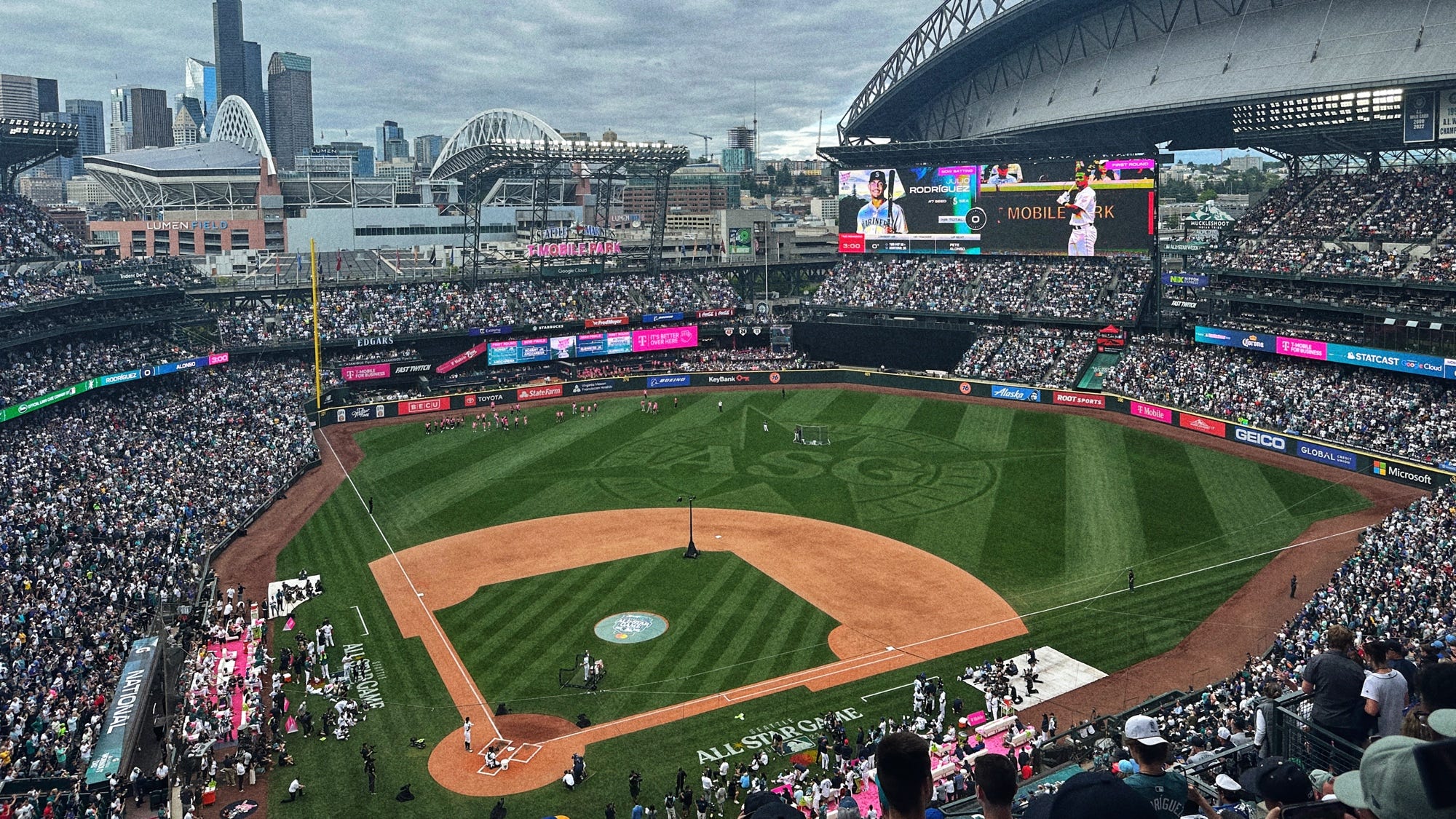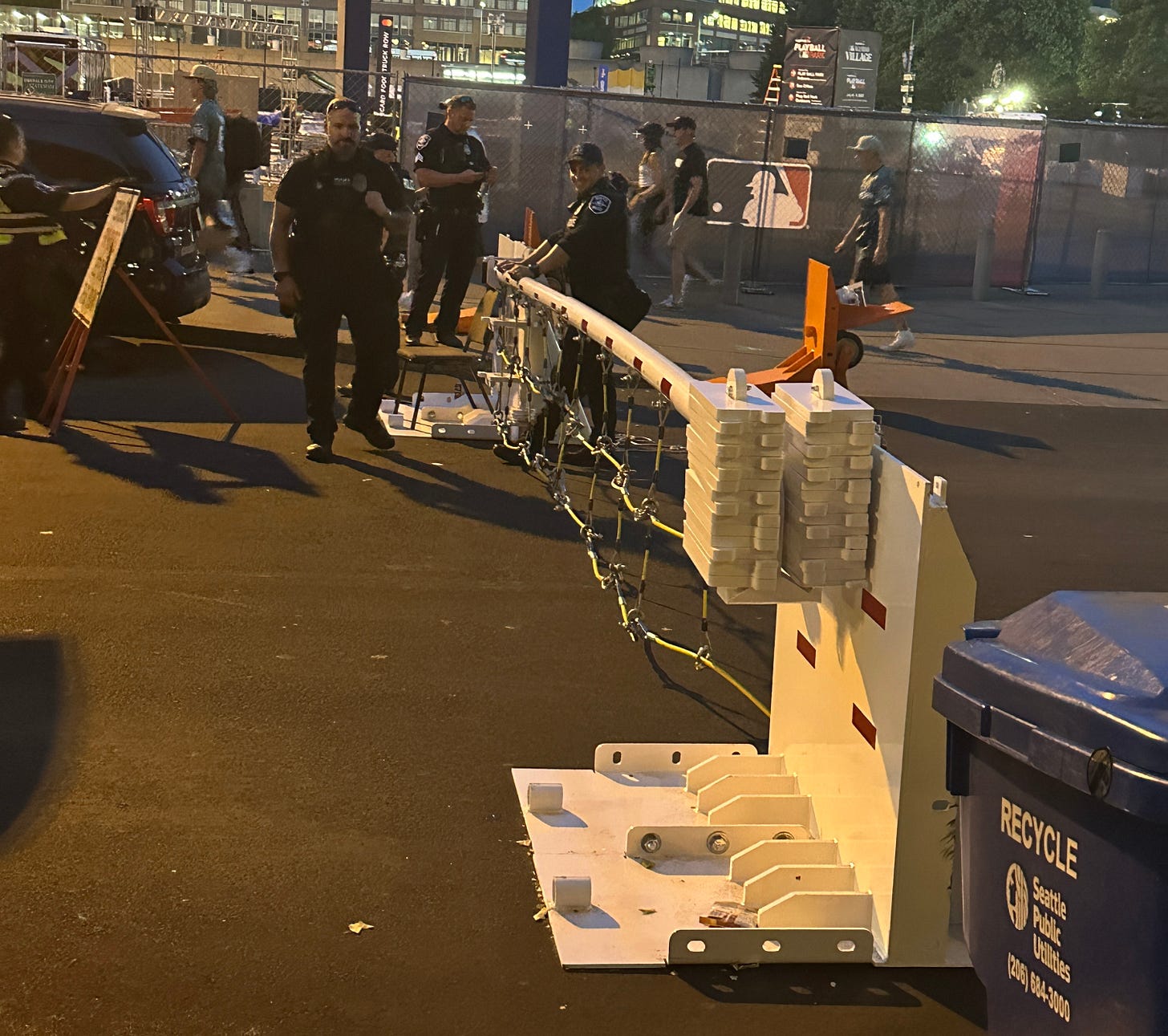Seattle is ready to be a world-class baseball town
Well, mostly.
The Julio round of the Home Run Derby was one of the greatest baseball moments I’ve ever seen. It was perfect. Two hundred and forty seconds of baseball bliss.
Swing after swing, barrel after barrel—honestly, I almost cried in disbelief.
This was a kid I met when he was 17 years old, never played baseball stateside, and here he was launching ball after ball into the upper tank in left with a packed T-Mobile Park devolving into euphoria.
My seats were, fittingly, up on the View Level with the skyline serving as the backdrop to this pageantry.
And it just all…fit.
I’m a touch late on this post but that is my lasting memory of the two days I spent at the ballpark, for the Derby and the All-Star Game itself—it all made sense, it makes sense to have what Major League Baseball calls its “jewel events” in this gem of a city and ballpark.
For good and for bad, you look around T-Mobile Park these days—made all the more stunning when every seat is filled because everyone wants to get their money’s worth on tickets starting at $200—and see this is a first-class facility.
They got the new big screen now 10 years ago. There are fancy ribbon boards everywhere. Even the dugout lid has an LED screen on it now. And of course, we can’t forget the multiple newly renovated luxury seating areas.
The ballpark was made—and maintained—to host big games.
Still though, when I say “Seattle” is ready, I mean its people above all else.
I should’ve known better, maybe—and even now I don’t have a good feel for the fan makeup of an event like the Super Bowl or NBA All-Star Game or whatever—but something I was struck by as I looked around at jerseys adorned with Rodríguez or Kirby or France or even Canó and Crúz was that this was an event for Seattle baseball fans.
And we reveled in it.
We love baseball
When I was a kid, it was a tradition to boo Alex Rodríguez. That’s just what we did. At some point it was more about it being funny to still boo ARod all these years later than it was to exhibit any actual malice.
Booing the Astros isn’t all the way to the latter yet, but it’s getting closer. We don’t care that Yordan Alvarez and Kyle Tucker weren’t on the 2017 team. Their cheating that year and beyond isn’t the only reason we loathe that organization.
Seattle sports fans are a passionate people and we’re going to show it.
It’s usually positive.
In the middle innings on Tuesday, fans around me had close eyes on the bullpen waiting to see when Luís Castillo might appear, before eventually being delighted to see George Kirby’s lanky frame progress to firing his upper-90s fastball out past the left field fence.
Before Kirby was announced, before he’d made it even 50 yards in from the bullpen, tens of thousands of M’s fans recognized their dude—their drafted, developed, now-dominant Dude—and erupted.
Before that, Ohtani. Ohhhh, Ohtani.
Fans of other teams may find that corny or distasteful or whatever, but how could you not, as an M’s fan, crack a big-ass smirk at the sound of that “Come to Seeeaaattle” ringing down from the upper deck in right and then echoing throughout the ballpark?
It was mostly for fun, but you never know. Maybe a spark hits the kindling just right.
When LeBron made the move from Cleveland to Miami in 2010, it was because of a seed that was planted at the 2008 Olympics, conversing with Dwyane Wade and Chris Bosh then.
Ohtani did little to douse what still are far-fetched hopes.
It’d be fun to look back, some six or so months from now, with Ohtani noting it was the fans who made a difference—who cemented this city as someplace special and someplace he wanted to be.
Seattle, its people, are ready for this to be one of the country’s best baseball towns. Well, many of its people. With some key figures, it’s in question.
The guy(s) up top
When super agent Scott Boras, a man as good at his job as anyone is at theirs, was asked by KJR why the game’s elite players—many his own clients—often avoid the organization, he was clear.
It’s ownership.
“Ownership has a lot to do with why athletes come to particular environments. When you're in free agent meetings...it's like in Texas, I had an owner involved with bringing Semien and Seager, saying ‘I'm going to commit, I'm going to give the resources, I'm gonna do the things.’
When players hear that and they hear it from ownership, it speaks volumes in their decision-making. Coveted free agents have many choices, many opportunities. Economic commitment is certainly part of it. But the reality of it is, when you're putting your roots down in one city, you want to make sure you're going to get the opportunity to win.
I think ownership addressing and speaking to that is a very important part of it.”
There’s a reason why, with his big clients, Boras always works through ownership. They control it all, they set the tone and they’re going to be the ones—many times—doing it longer than the GM or Baseball Ops president who’s trying to lure a particular player to town.
Is Boras incentivized to put pressure on ownership? Sure.
But nobody, anywhere, has a better feel for why elite free agents wind up with certain baseball teams and not elsewhere.
Until ownership exudes a mentality and displays actions that say “This is going to be a world-class organization,” it won’t be. It starts there.
And then, you have people and things outside the organization that just aren’t, well, all the way there.
The city
Instead of working at solutions proven to solve the problems facing Seattle, the city has chosen to attempt to stuff those problems in a closet and hope nobody from out of town peaks inside.
The city, its power brokers—they’ve known for a couple years this event was coming to Seattle. They also know the number one problem facing the city, in homelessness.
They didn’t work to put people in quality housing. Bluntly, they weren’t working to make sure there were fewer homeless people. It’s hard to say with any level of honesty that’s the target at this point.
After weeks and weeks of sweeps, after millions of dollars, after pulling cops off of working rape cases to sweep homeless camps, are there fewer homeless people now than there were at the beginning of July?
Of course not. And the Mariners are part of the power structure pushing hard to maintain the status quo.
Even closer to ground level on the day of the game, nothing about traversing the area around the ballpark felt like what you should feel in a world-class city.
Downtown was suffocated by cars—and it was somehow worse down in Pioneer Square. Down there we have a smidgen of a pedestrian plaza in Occidental Square, but not much more.
Biking in and parking in the team’s designated bike parking (which rocks) requires me to cross west over the new six-lane waterfront highway to get to a bike trail, then bike back east across First Ave and up Edgar Martinez Drive, which itself is a six-lane onramp for multiple interstates.
We can be better than this, and we can demand better than this.
Hell, we all know what we want, we know what’s great for a world-class baseball event. It isn’t a handful of cops within every 200 yards.
The city closed Pike Place to cars for the red carpet walk. Hell, they close Occidental almost every game.
In just the perfect anecdote for how the city is run, Seattle PD is armed to deploy surefire car-stopping gateways…but the Seattle Department of Transportation isn’t? We can’t get something functionally similar to this in way more places, for less money than this cost to do once?
This is the first time you’re getting my politics on this particular blog, but it certainly isn’t the first time you’re hearing what basically amounts to this publication’s thesis.
This city is special. This ballpark is special. Mariners fans are special.
But this could all be so much more.
There’s no reason this can’t be a better version of San Francisco to the north. It could be a European urbanist version of Boston to the Bay Area’s New York—except with a better baseball team.
Someday, I hope, we get to see that reality.




